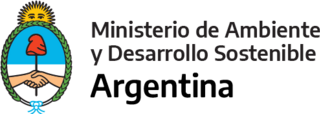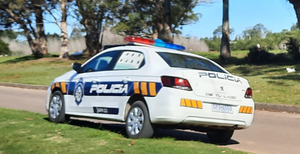
The Civil Guard is one of the two national law enforcement agencies of Spain. As a national gendarmerie, it is military in nature and is responsible for civil policing under the authority of both the Ministry of the Interior and the Ministry of Defence. The role of the Ministry of Defence is limited except in times of war when the Ministry has exclusive authority. The corps is colloquially known as the benemérita. In annual surveys, it generally ranks as the national institution most valued by Spaniards, closely followed by other law enforcement agencies and the armed forces.

The Argentine Federal Police is the national civil police force of the Argentine federal government. The PFA has detachments throughout the country. Until January 1, 2017, it also acted as the local law enforcement agency in the capital, Buenos Aires.
Dirección Nacional de Inteligencia Criminal is an Argentine intelligence agency, part of the National Intelligence System. It used to depend on the Secretaría de Seguridad Interior, which itself depends on the Ministry of Interior; currently, the DNIC depends from the National Ministry of Security. The DNIC is not a division of the Secretaría de Inteligencia (SIDE), which has its own Directorate of Interior Intelligence.

The Argentine Naval Prefecture is a service of Argentina's Security Ministry charged with protecting the country's rivers and maritime territory. It therefore fulfills the functions of other countries' coast guards, and furthermore acts as a gendarmerie force policing navigable rivers.

The Ministry of Defence is the government ministry responsible for safeguarding national security on land, sea and air. It exercises command over the Peruvian Armed Forces composed of the Army, the Navy and the Air Force. As of 13 February 2024, the minister of defense is Walter Astudillo.

The Police Community of the Americas or Ameripol is a hemispheric mechanism of cooperation police organization created in 2007.

The National Police of Peru is the national police force of Peru. Its jurisdiction covers the nation's land, sea, and air territories. Formed from the merger of the Investigative Police, the Civil Guard, and the Republican Guard in 1988, it is one of the largest police forces in Latin America. Its mission is to preserve domestic order, public order and national security, in order to enforce the law and protect the people of Peru. The PNP is controlled by the Ministry of the Interior. The PNP has a number of divisions, tasked with enforcing specific aspects of the law; among the more well known are DIROES, DIRANDRO, DIRINCRI, and DIRCOTE (Anti-Terrorism).
The Ministry of the Interior of Uruguay is the ministry of the Government of Uruguay that is responsible for controlling, regulating and evaluating policies, programs and plans related to public safety, as well as guaranteeing citizens the free exercise of fundamental rights and freedoms.

Investigations Police of Chile are the civilian police of Chile. Founded in 1933, it is one of two Chilean police bodies, along with the law enforcement police: Carabineros de Chile. The PDI is the principal law enforcement arm of the Public Prosecutor's Office of Chile in criminal investigation.
The Agencia Nacional de Inteligencia (ANI) is the Chilean government national intelligence agency. Created in 2004, its mission is to coordinate, and advise the President on, intelligence. It is attached administratively to the Ministry of the Interior. Its current director is Gonzalo Yuseff Quiroz. The previous director was Gustavo Villalobos, who was also the last director of Directorate of Public Security and Information. ANI's budget is approximately US$4 million.

Abdellatif Hammouchi is the head of the Moroccan national police directorate, the General Directorate for National Security or DGST as well as head of secret services, the General Directorate for Territorial Surveillance or DGST.

The Ministry of the Interior is a government ministry of Guatemala, headquartered in Zone 1 of Guatemala City.
The National Police of Honduras is the uniformed police force of the Republic of Honduras. The force is organised into regional headquarters, municipal headquarters, headquarters of fixed or mobile stations, and police posts. There are at least 360 police centres throughout Honduras. The National Police of Honduras has its headquarters in Tegucigalpa, the capital city of Honduras. The National Police of Honduras is the fourth largest police body in Central America by number of employees. It is the sixth largest force in Central America by police officers per capita. The force's patroness is the Virgin of Carmen. On 16 July of each year the "National Police Patroness Day" is celebrated.

The Ministry of National Defense of Uruguay is a ministry of the Government of Uruguay that is responsible for coordinating and executing all civil and military activities aimed at preserving the sovereignty, independence and the peace of the country. It is the administrative and executive body of the Armed Forces of Uruguay.

The Ministry of the Environment and Sustainable Development of Argentina was a ministry of the national executive power that oversaw the government's policy on environmental issues and promotes sustainable development.
The Defence Staff is an advisory body of the Ministry of National Defense of Uruguay on issues related to the planning and coordination of activities carried out by the Armed Forces. Created from Law 18,650 of February 19, 2010, its current headquarters was inaugurated in 2011, and is located on Avenida Luis Alberto de Herrera at its intersection with Monte Caseros St.

The Government Delegation for the National Plan on Drugs is the executive body of the Spanish Ministry of Health, attached to the Secretary of State for Health, which is responsible for the management, promotion, general coordination and supervision of the services in charge of updating and executing the National Plan on Drugs.
















